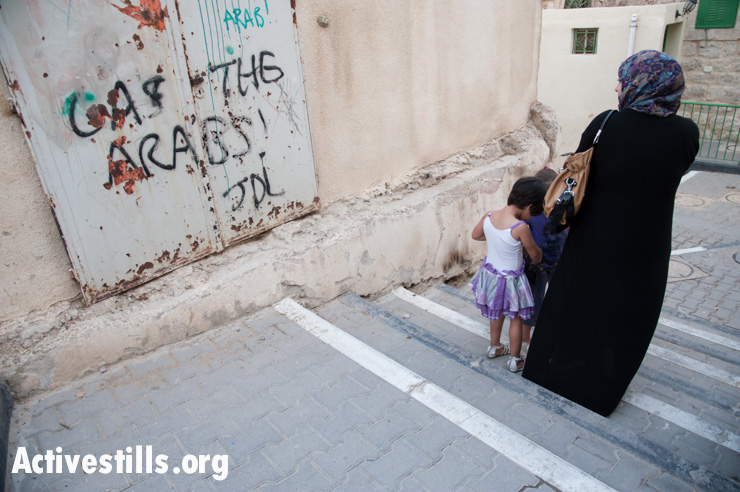Settlers went to Nibin Jamjum’s home specifically in order to shoot her in the head. All my attempts to bring about the murderer’s arrest have failed. A follow-up to the research of Israeli blogger-journalist “Eishton.”
(Translated from Hebrew by Ofer Neiman)
Israeli blogger-journalist Eishton brought me back in time to a two-year period in which I was trying to catch a murderer. In his recent well-researched article, he revisits the pogrom carried out by settlers in Hebron in July 2002. Following the murder of four Jews (including a 9-year-old boy), settlers went out on a three-day rampage, which culminated on a day on which they destroyed shops, stabbed and shot a large number of Palestinians in the Old City, assaulted policemen and soldiers and prevented the evacuation of the injured. They also murdered Nibin Jamjum, a 14-year-old girl.
Eishton provides a brilliant analysis of the police and army’s deliberate choice to refrain from protecting the Palestinians, from criticizing the settlers publicly in spite of the criticism which they voiced within their ranks, and from enforcing the law or arresting those suspected of crimes. As evidence, one notes that only a single settler was charged in relation to the entire pogrom, and only because he had assaulted an Israeli policeman.
I came across the story of Nibin Jamjum by accident, only because I was doing time with one of the participants in the Jewish pogrom in a tent in Military Prison Number 4 – in January 2003, six months after the murder. Kobi Hevroni, that was his name. A young man from the nearby settlement of Kiryat Arba who had gone AWOL and spent his free time perpetrating attacks on Palestinians. How do I know? Because he told us about it with pride in the tent. In my prison diary I took notes of his heroic tales, as told to the other prisoners: collecting arms, shooting at Palestinian shepherds, pogroms (which literally translates into the Hebrew word he actually used – “praot”) against the Arabs in Hebron – and all of this was carried out without any intervention by the Israeli army, to which he himself attested.

The extreme moments came when he told us about the murders. “It wasn’t me, it was the ‘criminals,'” he said, recounting how the “criminals” killed a 10-year-old red-haired boy because he used to curse them, and how one day they killed a 14-year-old girl because she had once spat at an Israeli border policeman. In my testimony at the military court, when I stood trial for refusal to enlist, along with four friends, I told the story, and added the following:
“I tried to convince myself that he was just bragging, that it couldn’t be true. But then I read case report number 15 by B’Tselem – and it’s simply there. Nibin Jamjum,14 years old, was murdered by settlers on 28.7.2002, at 14:00. No one was arrested, no one was brought to justice… Kobi was always nice to me, as he was to everyone else, to all the Jews in prison. He was funny, and he used to pass me socks when I was cold early in the morning during morning call. The contrast between this and his place of residence as well as the things he’s doing is too horrible for me.”
That was the only stage in my trial when the judge, Colonel Avi Levy (later a district court judge in Haifa) interrupted my testimony. He and the prosecutor, Captain Yaron Kostelitz (who in recent years has represented Michael Chernoy, Boaz Harpaz, Yaakov Efrati and Avigdor Liberman, and recently started his own law firm), instructed me to give my testimony to the Military Police Criminal Investigations Division (MPCID), and so I did.
It was to no avail. Two MPCID investigators questioned me, and the file didn’t move for four months on their end, until they announced that since Hevroni was being discharged from the army, he was no longer under their jurisdiction. In November 2003, two detectives from the Judea and Samaria district of the Israeli Police, Pini and Inbar, came to the base in which I was detained. At the end of the questioning, I wrote down a summary of sorts, and this is what it looked like:
Most of the questioning involved Pini pressuring me to insert into my testimony as many times as possible statements about Kobi not having given me identifying details of the criminals… I tried to stress what I did know as much as I could and provide a context for this. At some point, Pini realized I was making it difficult for him to insert all these dimmed down statements into my testimony, and he tried some sweet-talking. He told me I was showing exemplary citizenship, that he, too, would have refused to enlist for conscientious reasons, and said he was shocked by what the settlers were doing. He said he held Nibin Jamjum’s skull in his hands, and added that he wanted to catch the murderers. In retrospect, it suddenly seems strange that he would really hold her skull. When we said goodbye, Pini told me he put this whole thing about the lack of details in my testimony in order to ‘defend my credibility’ in court.
Time went by. Once every few months I contacted the police, trying to find out whether something had happened, if someone had been arrested, whether Kobi Hevroni had even been summoned to an interrogation. My parents wrote to the attorney general, and tried to get him involved in the case. Nothing. In February 2005 I got a terse letter from the police. The Nibin Jamjum murder case had been closed. The reason: “unknown perpetrator.”
Eishton’s report of Jamjum’s murder is based primarily on testimonies of her family, and most importantly that of her brother, who saw the settlers who entered their home and shot his sister in the head in front of him. What he couldn’t have known is that this was not just another incidental element of the pogrom – it was premeditated murder, committed by people who knew whom they were after, and that testimonies about the murder are still making the rounds, not just among the Palestinians but also among the settlers. And yet still, “unknown perpetrator” and a cold case.
By the way, I too have never managed to find out who the ten-year-old red-haired boy was, the other victim Hevroni mentioned.
Read this story in Hebrew on +972’s sister site, “Local Call.”

